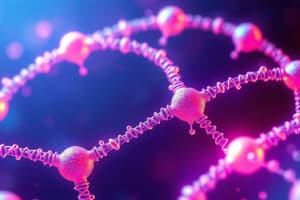Podcast
Questions and Answers
What is the primary material of the core in a nanowire?
What is the primary material of the core in a nanowire?
- Insulator
- Conducting polymer
- Secondary material
- Primary material (correct)
Which type of nanowire morphology is characterized by having multiple branches?
Which type of nanowire morphology is characterized by having multiple branches?
- Branched nanowires (correct)
- Hollow nanowires
- Bent nanowires
- Core-shell nanowires
Which synthesis method is NOT mentioned as a way to control the structure of nanowires?
Which synthesis method is NOT mentioned as a way to control the structure of nanowires?
- Sol-gel process (correct)
- Chemical vapor deposition
- Molecular beam epitaxy
- Electrochemical deposition
What aspect of E-beam lithography enables the creation of patterns without the use of masks?
What aspect of E-beam lithography enables the creation of patterns without the use of masks?
Which of the following materials can constitute the shell of a nanowire?
Which of the following materials can constitute the shell of a nanowire?
What is the maximum resolution that E-beam lithography can achieve?
What is the maximum resolution that E-beam lithography can achieve?
Which synthesis method involves liquid and solid phases for nanowire growth?
Which synthesis method involves liquid and solid phases for nanowire growth?
What type of materials are typically used as the surface of nanowires?
What type of materials are typically used as the surface of nanowires?
Flashcards are hidden until you start studying
Study Notes
Nanowire Structure
- Nanowires have a core, shell, surface and interfaces.
- The core contains the primary material.
- Some nanowires have a shell of a secondary material.
- The surface can be functionalized with chemicals or other materials.
- Interfaces occur where nanowires meet substrates or other nanowires.
- Nanowires can be composed of metals like gold, silver, and copper.
- Semiconductors such as silicon, and germanium are also used.
- Nanowires can be made from insulators like silicon dioxide and alumina.
- Conducting polymers like PEDOT and PANI can also be used.
Nanowire Shapes
- Straight nanowires are common.
- Bent or curved nanowires can be created.
- Branched or tree-like nanowires have highly complex structures.
- Core-shell nanowires have a distinct core and surrounding shell.
- Hollow nanowires have a central cavity.
Nanowire Synthesis Methods
- Vapor-liquid-solid (VLS) growth is a popular technique.
- Solution-liquid-solid (SLS) growth is another method.
- Chemical vapor deposition (CVD) is commonly used.
- Molecular beam epitaxy (MBE) offers precise control over nanowire growth.
- Electrochemical deposition is a simple and versatile technique.
Electron-Beam Lithography (EBL)
- EBL uses a focused beam of electrons to create high-resolution patterns on a substrate.
- This technique is crucial for microelectronic and nanotechnology applications.
- A resist material changes its chemical structure when exposed to the electron beam.
- The beam is scanned across the substrate to create a pattern in the resist material.
- EBL achieves resolutions down to 10 nm or smaller.
- No mask is required, as the pattern is created directly on the substrate.
EBL Applications
- Microelectronics: fabrication of integrated circuits, transistors, and other semiconductor devices.
- Nanotechnology: creation of nanostructures, such as nanowires, nanotubes, and nanoparticles.
Studying That Suits You
Use AI to generate personalized quizzes and flashcards to suit your learning preferences.



